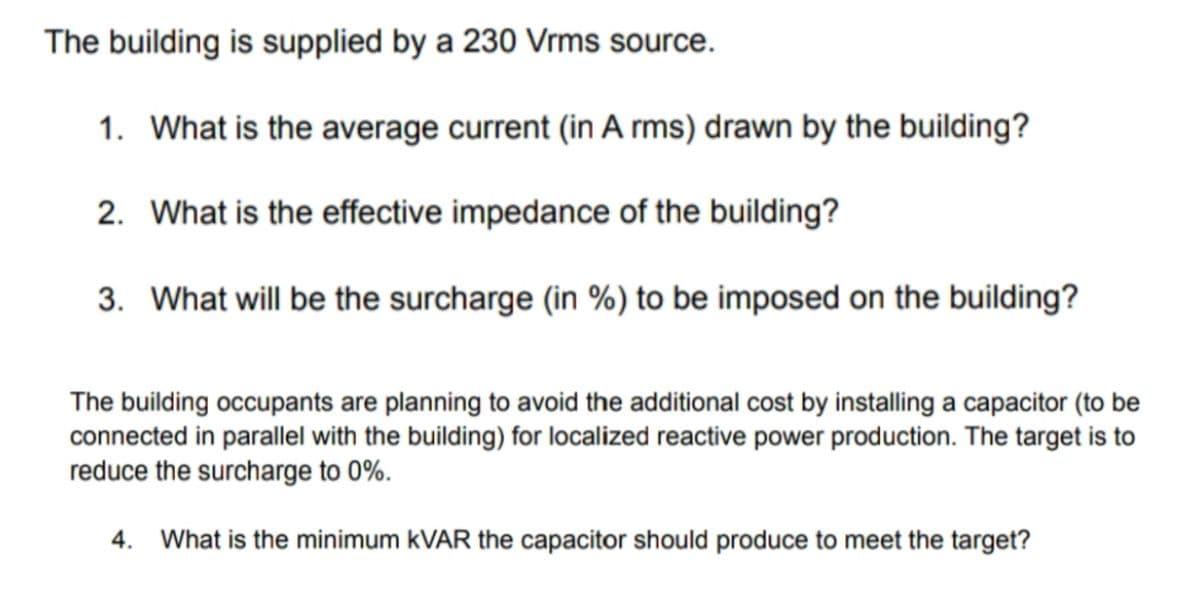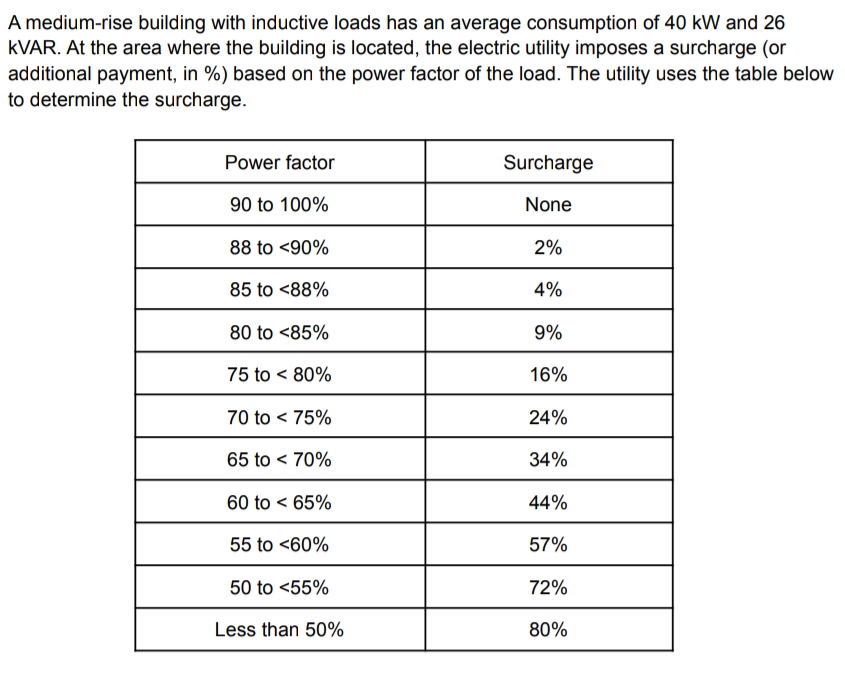The building is supplied by a 230 Vrms source. 1. What is the average current (in A rms) drawn by the building? 2. What is the effective impedance of the building? 3. What will be the surcharge (in %) to be imposed on the building? The building occupants are planning to avoid the additional cost by installing a capacitor (to be connected in parallel with the building) for localized reactive power production. The target is to reduce the surcharge to 0%. 4. What is the minimum KVAR the capacitor should produce to meet the target?
The building is supplied by a 230 Vrms source. 1. What is the average current (in A rms) drawn by the building? 2. What is the effective impedance of the building? 3. What will be the surcharge (in %) to be imposed on the building? The building occupants are planning to avoid the additional cost by installing a capacitor (to be connected in parallel with the building) for localized reactive power production. The target is to reduce the surcharge to 0%. 4. What is the minimum KVAR the capacitor should produce to meet the target?
Power System Analysis and Design (MindTap Course List)
6th Edition
ISBN:9781305632134
Author:J. Duncan Glover, Thomas Overbye, Mulukutla S. Sarma
Publisher:J. Duncan Glover, Thomas Overbye, Mulukutla S. Sarma
Chapter2: Fundamentals
Section: Chapter Questions
Problem 2.22P: The real power delivered by a source to two impedances, Z1=4+j5 and Z2=10 connected in parallel, is...
Related questions
Question

Transcribed Image Text:The building is supplied by a 230 Vrms source.
1. What is the average current (in A rms) drawn by the building?
2. What is the effective impedance of the building?
3. What will be the surcharge (in %) to be imposed on the building?
The building occupants are planning to avoid the additional cost by installing a capacitor (to be
connected in parallel with the building) for localized reactive power production. The target is to
reduce the surcharge to 0%.
4. What is the minimum kVAR the capacitor should produce to meet the target?

Transcribed Image Text:A medium-rise building with inductive loads has an average consumption of 40 kW and 26
KVAR. At the area where the building is located, the electric utility imposes a surcharge (or
additional payment, in %) based on the power factor of the load. The utility uses the table below
to determine the surcharge.
Power factor
Surcharge
90 to 100%
None
88 to <90%
2%
85 to <88%
4%
80 to <85%
9%
75 to 80%
16%
70 to < 75%
24%
65 to 70%
34%
60 to <65%
44%
55 to <60%
57%
50 to <55%
72%
Less than 50%
80%
Expert Solution
This question has been solved!
Explore an expertly crafted, step-by-step solution for a thorough understanding of key concepts.
Step by step
Solved in 3 steps with 2 images

Knowledge Booster
Learn more about
Need a deep-dive on the concept behind this application? Look no further. Learn more about this topic, electrical-engineering and related others by exploring similar questions and additional content below.Recommended textbooks for you

Power System Analysis and Design (MindTap Course …
Electrical Engineering
ISBN:
9781305632134
Author:
J. Duncan Glover, Thomas Overbye, Mulukutla S. Sarma
Publisher:
Cengage Learning

EBK ELECTRICAL WIRING RESIDENTIAL
Electrical Engineering
ISBN:
9781337516549
Author:
Simmons
Publisher:
CENGAGE LEARNING - CONSIGNMENT

Power System Analysis and Design (MindTap Course …
Electrical Engineering
ISBN:
9781305632134
Author:
J. Duncan Glover, Thomas Overbye, Mulukutla S. Sarma
Publisher:
Cengage Learning

EBK ELECTRICAL WIRING RESIDENTIAL
Electrical Engineering
ISBN:
9781337516549
Author:
Simmons
Publisher:
CENGAGE LEARNING - CONSIGNMENT